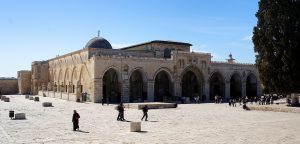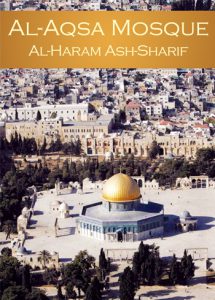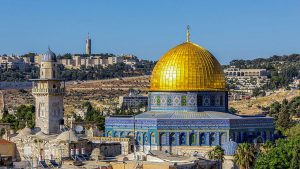There are 32 water sources inside Al-Aqsa Mosque: two pools, two cisterns, eight sabeels (a public water source that is meant to service people for free), and twenty wells, that were built and dug out by Muslims to provide running water sources for worshipers inside Al-Aqsa Mosque to perform ablution, drink and irrigate the plants and trees inside the compound.
1) Al-Ka’as
Al-Ka’as is an ablution that was built by the Ayoubi Sultan Al-Adel Abu Bakr bin Ayoub in 589 AH/1193 AC. It is a circular basin with a fountain in the middle which is surrounded by an ornamented iron fence encircled by stone stools. It has a number of side faucets pinned on it for wadu’ (ablution). Al Ka’as was last renovated by Sultan Qaitbay and Prince Tankz An-Nasiri in 728 AH/1327 AC.
2) Sabeel Qaitbay
Sultan Saif Ad-Din Ennal built this sabeel in 860 AH; however, only a well remained of its original structure. The Mamluk Sultan Qaitbay reconstructed the Sabeel and added the building made of colourful bricks and the marble floors. The building is also topped with an octagonal dome ornamented with Islamic motifs. The sabeel was renovated again by the Ottoman Sultan Abdul Majid Khan in 1300 AH/1882-1883 AC. Today, it is made of two floors; the first floor has a well on its grounds, while the second is a tank used for storing water.
3) Sabeel Qasem Pasha
Sabeel Qasem Pasha is located on the southwest side of Al-Aqsa Mosque close to the Gate of the Chain. Built by Qasem Pasha the Prince of Jerusalem in 933 AH/1527 AC, it is an octagonal sabeel with 16 faucets connected to it and a wooden sunshade built over it. The Sabeel is also called the Sabeel of the Courthouse.
4) Sabeel Suleiman
Sabeel Sultan Suleiman the Magnificent is located near the Gate of Darkness over a platform that carries the same name; it was endowed in 948 AH/1541 AC. The Islamic Heritage Committee in coordination with the Waqf Directorate added an ablution to it in 1997 between the Sabeel’s building and the Dome of the Prophet’s Lovers.
5) An-Narenj Pool
An-Narenj (‘bitter oranges’) pool is located on the western courtyard of Al-Aqsa Mosque between Sabeel Qasem Pasha and Sabeel Qaitbay’s platform. The Mamluk Sultan Qaitbay renovated it in 887 AH/1483 AC when he built Al-Ashrafyah School. The pool is square-shaped and has a fountain with marble floors in the middle of it which is out of use today. Al-Aqsa Reconstruction Committee renovated the pool and turned it into an ablution by adding 24 faucets on three of its sides. It is supplied with water from the nearby tank of Sabeel Qasem Pasha.
6) King Issa Al-Moathem Cistern
King Issa Al-Moathem ordered building the cistern in 607 AH/1210 AC just after the Grammarian Dome was built in 604AH/1207AC. The cistern is made of three hallways that are separated by constructed partitions and are covered with overlapping vaults. It has three entrances on its southern side where the cistern’s year of construction and its founder’s name are engraved over the middle door. During the Mamluk Sultan Al-Mansour Qalawun’s reign part of the cistern was used as a storage room for Al-Aqsa Mosque, while the other part was used as a mosque for the Hanbaliya. The cistern later suffered from negligence and is used today by Al-Aqsa’s Gardening Department.
Source: Palestinian Academic Society for the Study of International Affairs, Jerusalem


